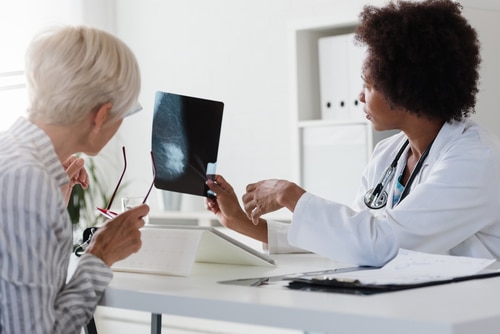As the second-most common cancer affecting women in the United States, screening for breast cancer is incredibly important to maintaining a woman’s health. On a recent episode of the Healthful Woman podcast, Dr. Christina Weltz explained the basics that patients should know about breast cancer diagnosis and common treatment options, as well as clearing up common misconceptions.
Diagnosing Breast Cancer
The basic steps in detecting and diagnosing breast cancer include self-exams, routine breast exams with your doctor, screening mammograms, and diagnostic ultrasounds as needed. If a diagnostic ultrasound or other imaging test shows concerning results, a radiologist would then recommend a needle biopsy.
In the past, surgery was required to biopsy breast tissue when cancer was suspected. Today, a simpler outpatient procedure is sufficient. “The needle biopsies are what we call core biopsies, where it’s an outpatient procedure done in the radiologist’s office,” explains Dr. Weltz. This involves “a large-bore needle that is put into the lesion and pulls out a sample.” This tissue sample allows pathologists to then diagnose not just whether it is cancerous but the specific type of cancer, whether it is estrogen positive, and other factors. Using this information, a breast surgeon or oncologist can then recommend the best treatment options.
Breast Cancer Treatment
In the majority of cases, breast cancer treatment involves surgery to remove the cancerous tisse and cells. A mastectomy is when the entire breast (or breasts) is removed and a lumpectomy is when only a portion of the breast tissue is removed. As Dr. Weltz explains, “with very rare exception, women who are diagnosed with breast cancer will need surgery.”
Choosing between lumpectomy and mastectomy depends on the extent and location of the cancerous tissue and the specific type of breast cancer. Patients with cancerous tissue localized to one small tumor are typically able to undergo lumpectomy, while those with “in-situ” cancer spread throughout the breasts will usually require mastectomy. Dr. Weltz says that there is a “misconception that bigger surgery means bigger cure. But the fact of the matter is that women who can have lumpectomies should not feel that they’re compromising their care by having that as opposed to having a mastectomy.” In addition to these surgeries, many will also require chemotherapy or radiation therapy, depending on factors like the stage of their cancer.
Following a lumpectomy or mastectomy, patients can then opt for breast reconstruction surgery. Modern techniques in lumpectomy and mastectomy take care to spare as much healthy skin as possible, making it easier for a plastic or reconstructive surgeon to create a new breast that looks as natural as possible.
Schedule an Appointment
To learn more about breast cancer treatment, diagnosis, and prevention, schedule an appointment at Carnegie Women’s Health in New York City. Call our office at (315) 628-7063 or contact us online to set up your first appointment.

